
The Gland Factor by James L. Bruner
article copyright
Understanding the functions of deer glands can play a primary role in deciphering one of the complex languages that deer use throughout the year. As we become more acquainted with the anatomy of deer, researches allow more insight into the inner workings dealing with areas such as glands which go hand-in-hand with visual and audible communication in and amongst the deer herd.
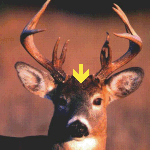 The Forehead Gland
The Forehead Gland
There is a lot of documentation regarding the forehead gland and its use for communication purposes. One main attribute is that deer secrete an oily substance from these glands which darkens the immediate area on the frontal lobe portion between the antlers. This will normally be more pronounced on older more dominant deer. Predominantly this gland is used for marking purposes primarily when making rubs on trees. The oily secretion from the forehead glands contain a genetic calling card in regards to social status and hierarchy amongst the local deer herd. Typically a more dominant buck will make rubs with more frequency to announce his presence and stature. It has been said that the pheromones contained within the forehead gland are actually used to “kick start” or “announce” the coming of the next rutting phase. With rubbing beginning very early in the year, I believe there may less credentials to this statement. Regardless of scientific studies and personal beliefs, the act of making rubs is no longer known as simply a signpost for other deer to view as once believed. The forehead gland distinctly leaves a scented trademark personalized to each deer.
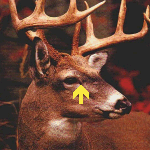 The Preorbital Gland
The Preorbital Gland
This gland has been debated on its functions for some time now. Research indicates that the scent released from this gland is used for communication when a deer rubs its face against brush or trees. Others remark that it used for visual communication purposes between all deer but has particularly been noted between nursing mothers and fawns and also to dictate social order between dominant deer of the herd. The Preorbital ahs also been referred to as the “tear duct” gland, possibly for its relevance according to location, but studies reveal this gland “does not” produce tears.
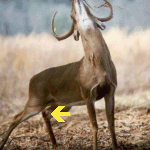 The Tarsal Gland
The Tarsal Gland
This is the most common gland amongst hunters and many commercial products have been introduced to simulate this area. Located just inside the hocks on the hind quarters of a deer, the tarsal gland is one of the most visible and pronounced forms of scent communication between deer. All deer of the whitetail family use this form of association but it is most acquitted to the bucks during the rutting phase. Although does and fawns will urinate on their hocks and rub their legs together, the social status is most defined for the male portion of the herd. During the rut bucks will use a technique called rub-urination which entails the deer urinating on his hind quarters and rubbing the inside of his legs together. This darkens the tarsal gland and acts as a signature of dominance when scented by other deer. Bucks will often adhere to this procedure when creating or freshening a scrape. As a buck becomes more engaged in the rut his tarsal gland will become dark, nearly black, in color.
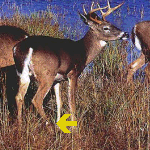 The Metatarsal Gland
The Metatarsal Gland
Very little is known about this gland in particular which has led to much observation and speculation. Located on the outside of the hind legs and varying in color from white to tan, it’s average size is 1 1/2″ in length. Some researches have commented that this gland was actually used in correspondence to regulating body heat. Personally I believe that statement to be false due in part mainly to its location and for no other reason. Other suggestions have remarked that it’s possible use is to release scent when alarmed or leave scent along the taller grasses as the deer continues its routine travels throughout the year. And yet another researcher admits that these are not glands at all due to their lack of ducts necessary for glands to produce scents. If the metatarsal is truly considered a gland, I would be more apt to believe that it is used to scent mark trails due again to its location. Much like that of the interdigital gland.
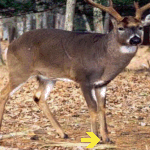 The Interdigital Gland
The Interdigital Gland
This gland is located between the toes of deer and used mainly for trail marking and locating one another. Some experts theorize that fawns do not have developed interdigital glands to help evade predators while others lay claim that a nursing mother will follow her fawns interdigital scent to re-locate the animal should they become separated. One obvious trait that all researchers and experts agree on is that this gland is used to announce their presence and also danger. When a deer stomps its hooves on the ground it not only sends an audible alert but also a stamps a scented alert that danger is nearby. Deer visiting the area at a later date would instinctively realize that the possibility of danger could still be present in the area long after the action had already occurred.

